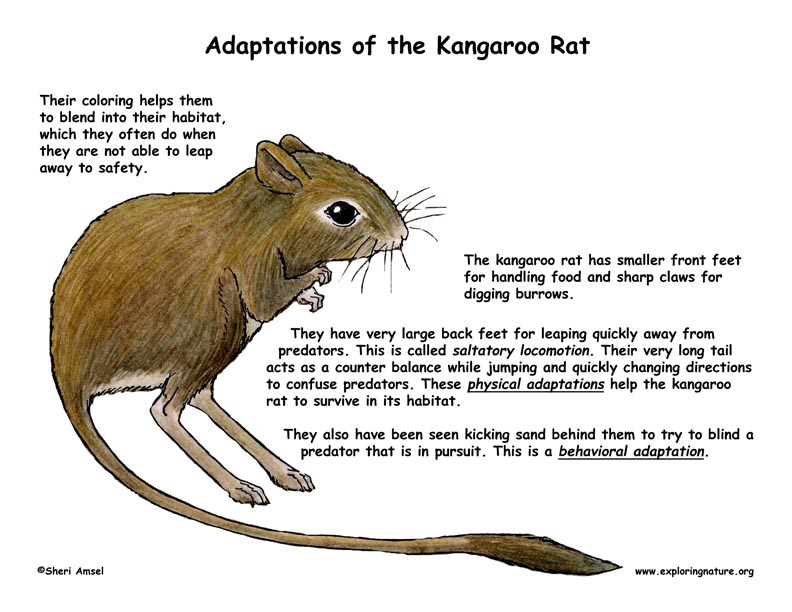

Adaptation in a population of living things happens as a result of an adaptive trait. This is any inheritable trait that increases its survival rate so that it can live longer, reproduce longer, and have more offspring (that also have that trait). Adaptive traits can improve an animal's ability to find food, make a safer home, escape predators, survive cold or heat or lack of water.
The kangaroo rat looks like a mouse-sized kangaroo with very large back feet for leaping quickly away from predators. This is called saltatory locomotion. Their very long tail acts as a counter balance while jumping and quickly changing directions to confuse predators. If a kangaroo rat cannot escape by jumping away, it will stay very still. Its fur color matches the sand and rocks where it lives in the deserts of the Southwestern U.S. This acts as camouflage and helps them to blend in. Camouflage is another important physical adaptation. It protects the kangaroo rat from hungry foxes, snakes, owls and coyotes. If the predators can’t see them, they can’t eat them.
The kangaroo rat has smaller front feet for handling food and sharp claws for digging burrows. All these physical adaptations help the kangaroo rat to survive in its habitat.
They also have been seen kicking sand behind them to try to blind a predator that is in pursuit. This is a behavioral adaptation.
For Discussion and Critical Thinking:
The kangaroo rat has adaptive traits that helps it survive in its hot, dry, open desert habitat.
1. Name two of the kangaroo rat’s adaptive traits and how it helps it survive:
2. Name two animals from your yard, local parks or wild areas (forests, prairies, wetlands, etc.) who use the same type of jumping locomotion as the kangaroo. For each explain how the animal is physically different from the kangaroo rat despite its jumping trait.
3. Why would the kangaroo rat’s physical traits not work in a forested habitat?
When you research information you must cite the reference. Citing for websites is different from citing from books, magazines and periodicals. The style of citing shown here is from the MLA Style Citations (Modern Language Association).
When citing a WEBSITE the general format is as follows.
Author Last Name, First Name(s). "Title: Subtitle of Part of Web Page, if appropriate." Title: Subtitle: Section of Page if appropriate. Sponsoring/Publishing Agency, If Given. Additional significant descriptive information. Date of Electronic Publication or other Date, such as Last Updated. Day Month Year of access < URL >.
Amsel, Sheri. "Adaptations of the Kangaroo Rat" Exploring Nature Educational Resource ©2005-2024. December 13, 2024
< http://mail.exploringnature.org/db/view/1683 >

